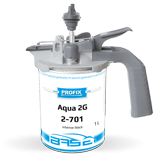Recently added
Related products
Most read
Why use the water-soluble lacquers, when the conventional ones are available?
Future trends in paint industry
Future trends in paint industry
From school time we remember watching the world under an optical microscope, which allowed a magnification of 100x. We could see the construction of really small elements of the natural world, but not those nano-sized ones. Times are changing and advanced laboratories have long forgotten about working on such equipment. Now the word nanotechnology can be found at every step of everyday life.
What is nanotechnology and what can be used for?
First of all, nanotechnology allows the creation of structures at atomic or molecular level. This is a relatively new approach that refers to learning and improving the properties of matter in the ‘nano’ scale: one nanometer (one billionth of a meter). But how big are these particles. This implies equating the human hair whose thickness is 1000 times bigger than nano-structure compared next to it. Let's consider why researchers are so focused on such small elements that we cannot even see. Contrary to appearance, something so small shows a completely different, often surprising physical abilities, which blurs the boundaries between scientific and technical disciplines.
Exploration of nanotechnology is widely used. Nano-oriented research have enormous potential, which, in the short term, will result in a revolution in many areas of our lives. Manipulating at the molecular level is evidently the direction in which future nano-products (including lacquers) will dictate over the years. Nanotechnology has contributed to the development of specialized coatings known as "smart coatings". These include:
- Self-etching paints for exterior paint coatings, used for painting spaceships and SpaceX missiles for years, are being shipped internationally. Now, in the automotive industry, you can meet such varnishes applied in premium cars.
- Camouflage coating materials for the defense industry, which can be seen in many prototypes of new military equipment. Unfortunately, nowadays the biggest problem is the durability of such a coating.
- Signaling leakage and breakdowns coatings will not only be available in building applications but also in automotive applications over time, making leak detection much faster and easier to detect.
- Coatings that react in a certain way to temperature fluctuations. Such thermal coatings may already be present and their use in automotive tuning is becoming standard.
- The term "smart coatings" also applies to antibacterial paints that use silver nanoparticles. These materials are sometimes referred as "functional coatings" because of the function they serve. Some of the fillers (e.g. silicas) increase the mechanical resistance of wood coatings, and the nano-sized oxides protect painted surfaces against UV rays and provide good anticorrosive properties. In lacquer production nano-products are also used as a lacquer binder that enhances adhesion to the substrate, providing excellent filling of the substrate pores.
Self-cleaning car paint
Silver nanoparticles exhibits much stronger bactericidal and fungicidal activity than macro or micro silver and its efficiency increases proportionally with the reduction of particle size. German and Japanese car consortia are positively oriented towards this technological solution. Research on the use of such coatings in public transport is underway. Self-cleaning and additionally anti-bacterial surfaces can work miracles in the face of constantly growing cities (Tokyo already has 38 million inhabitants). In the production of coatings organic and inorganic materials are being used, but also cutting-edge materials, such as composites and metamaterials.
Although, new technologies for the production of functional coatings have recently been mass-produced, they are often only on a laboratory level that cannot be applied on large scale. The challenge for technologists will be to adapt these methods to the needs of industry so that functional layers can be applied to objects of any size.
Another problem with this type of coating is an undesirable interference between the various layers used on the painted surfaces. We see that there is still a long way to go to get products that meet all expectations. Sometimes we see products that we do not always appreciate. For example we can take care of our car's coating ourselves to be a little “self-cleaning”. Simply apply wax (e.g. WAX by Profix) and, without journey to the nano-world, we receive not only the perfect coating of the paint, but equally important long-term maintenance of the surface.
There will be millions out of nano
Reports from a company dealing with broad market analysis of "nano-products" show that sales of nanotech-based coatings in 2021 will exceed $ 1 billion. Experts took into consideration the main areas of use of functional coatings: construction, automotive, aviation, medicine, textile industry. The largest sector of application of varnishes products is construction - in 2021 the value of sales in this industry will already be around $ 625 million. These will be primarily self-cleaning coatings, but they require improvement in terms of durability - currently available solutions are not sufficiently resistant to the harsh climatic conditions, in which roofs and facades usually work.
The second is automotive. The value of functional coatings sold to this sector in the year 2021 reaches $ 450 million, the best chance for expansion in the industry are self-healing varnishes. Thanks to them we will no longer have to be afraid of scratches on the bodywork of our cars.











